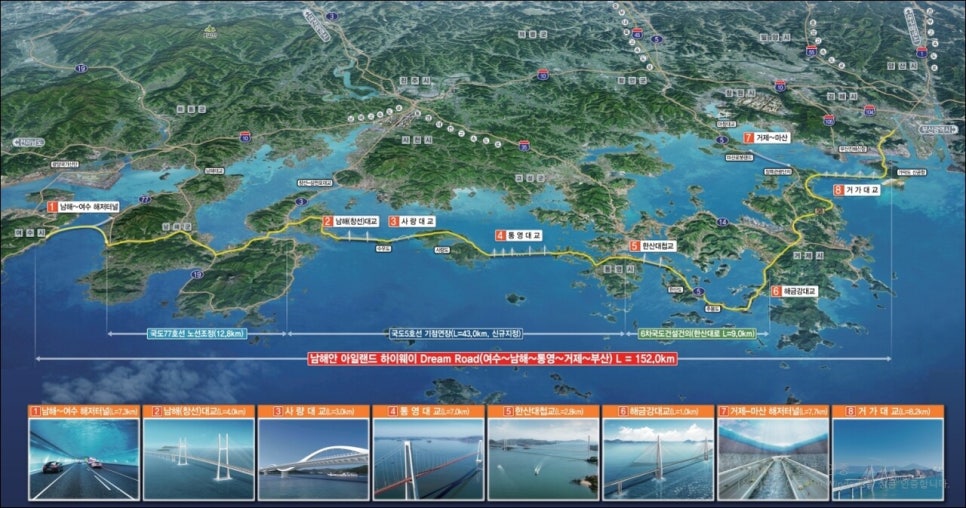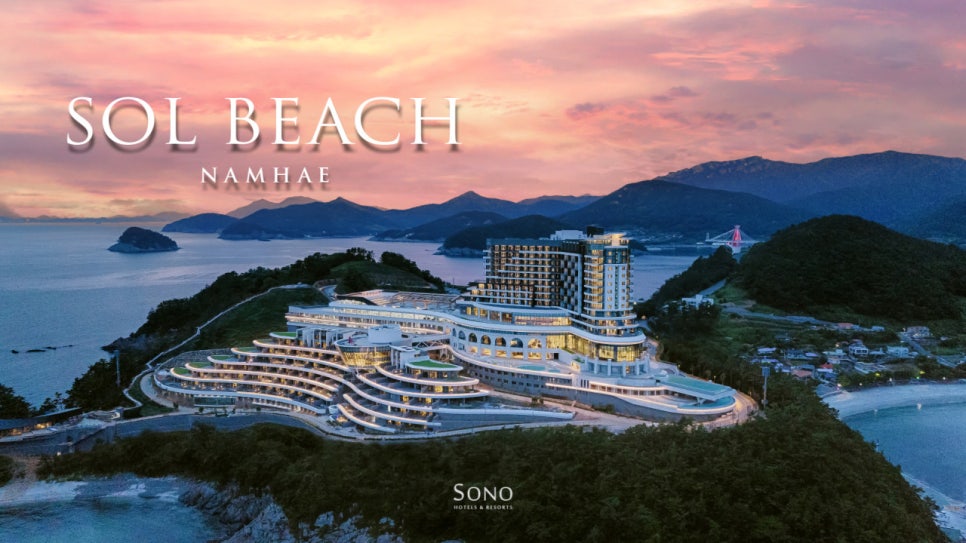Table of Contents
- Realization of the 'Dream Road'... 43km Extension of National Road No. 5 from Tongyeong to Namhae
- Including 5 Marine Bridges... Creating a Marine Tourism Belt Connecting Namhae, Tongyeong, Geoje, and Busan
- Anticipated Economic Ripple Effect Exceeding 5.7 Trillion Won
- Improving Quality of Life for Residents in Island Areas... Expectation of Ensuring Basic Transportation Rights
- Gyeongnam Province Accelerates Preparation to Become a Marine Tourism Hub in Local Era
- Conclusion: The 'South Coast Island Connection Marine National Road' as a Catalyst for Balanced Regional Development and Tourism Renaissance
- Frequently Asked Questions (FAQ)
Realization of the 'Dream Road'... 43km Extension of National Road No. 5 from Tongyeong to Namhae

The Island Connection Marine National Road project being carried out by Gyeongnam Province is undergoing significant changes with the confirmed extension of National Road No. 5 by the Ministry of Land, Infrastructure and Transport.
On July 9, the Ministry announced a plan to extend National Road No. 5 by 43km from Donam-dong, Tongyeong City to Changseon-myeon, Namhae-gun. As a result, this section has officially been recognized as a national road.
This decision is expected to greatly contribute to improving the transportation network and activating the economy in the South Coast region.

This decision has significant implications as a crucial section of the 'South Coast Island Connection Marine National Road,' a major project of Gyeongnam Province, has been included in the national road network. While it is still early to mention the construction timeline, it provides a foundation for upcoming procedures such as budget allocation, design, and construction, given its inclusion in the national road network.
Moreover, the Hansan Battle Bridge in Tongyeong and the Namhae-Yeosu underwater tunnel project are already underway and are expected to positively impact regional development.
Including 5 Marine Bridges... Creating a Marine Tourism Belt Connecting Namhae, Tongyeong, Geoje, and Busan

Recent route extensions have laid the groundwork for the construction of five large marine bridges: Shin Namhae Bridge, Saryang Bridge, Shin Tongyeong Bridge, Hansan Battle Bridge, and Haenggeumgang Bridge.
This will enable the establishment of a marine national road network connecting the island regions of the South Coast, known as the 'Island Highway.' Such changes are expected to further enhance regional development and transportation convenience.

The marine national road spanning 152 km along the South Coast connects Yeosu, Namhae, Tongyeong, Geoje, and Busan. This road will serve as a central route integrating the South Coast into a marine tourism and living area, linking with existing underwater tunnels and the Geoga Highway.
Anticipated Economic Ripple Effect Exceeding 5.7 Trillion Won

According to a report by the Gyeongnam Research Institute, the completion of the marine national road connecting the South Coast islands is expected to bring significant economic benefits. The production inducement effect is expected to reach 4 trillion won, while the value-added effect is projected to be approximately 1.7 trillion won.
Additionally, the project is expected to create around 25,518 jobs. With reduced travel times and decreased vehicle operating costs, as well as expected accident prevention effects, it is analyzed that social costs can be reduced by 116.5 billion won annually.

The daily traffic volume on this route is expected to reach approximately 17,606 vehicles by 2030, indicating its vital function as a major transportation axis connecting islands and the mainland.
Improving Quality of Life for Residents in Island Areas... Expectation of Ensuring Basic Transportation Rights

The primary beneficiaries of this project are the residents of the island areas.
They can escape reliance on ferries, which were limited by weather conditions, and achieve stable year-round movement through directly connected transportation networks with the mainland. This also significantly improves accessibility to emergency medical services; for example, residents of Saryangdo can reach Tongyeong General Hospital in just 15 minutes. Such changes are expected to drastically enhance the living conditions of island residents.

The travel time between Namhae and Tongyeong will be reduced from the current one hour to about thirty minutes, and with the opening of Gadukdo new airport, access time between Namhae and Busan is expected to be shortened by over 40 minutes.
As the South Coast enters a tourism era, various resorts and hotels, such as Sol Beach and Shilla Hotel, are being developed, which is expected to attract tourists. However, the lack of access from Geoje and Tongyeong to Namhae remains a concern. If this project progresses smoothly, the South Coast tourism connecting Geoje, Tongyeong, Namhae, and Yeosu is expected to become more active, which is anticipated to positively impact regional economic development.
Gyeongnam Province Accelerates Preparation to Become a Marine Tourism Hub in Local Era

Gyeongnam Province has recently set a goal to develop the South Coast region into a major marine tourism hub in Northeast Asia, using the upgrade of the national road as a stepping stone. To achieve this, they plan to strengthen the road brand alongside tourism resources, enhance connectivity with the southern inland railroad and Gadukdo new airport, and build various infrastructures such as marinas, cruise ships, and marine healing centers.
In particular, they aim to promote marine complex tourism development through creating marine landmarks that combine historical elements and natural scenery, such as the Hansan Battle Bridge, and attract private investments to ensure that the marine national road connecting South Coast islands becomes a new axis of tourism in Korea.
Conclusion: The 'South Coast Island Connection Marine National Road' as a Catalyst for Balanced Regional Development and Tourism Renaissance

The 43km extension of National Road No. 5 is a significant first step in the 'South Coast Island Connection Marine National Road' project, signaling a new change in South Korea's marine tourism policy. Although the project schedule has not yet been determined, its inclusion in the national road network greatly enhances the likelihood of future project progression.
This project is expected to ensure the basic transportation rights of residents in island areas, activate local economies, and promote the development of the tourism industry. We hope it can become a new center for the Korean economy beyond the South Coast region.
#SouthCoastIslandConnectionMarineNationalRoad, #ExtensionOfNationalRoadNo5, #ConstructionOfTongyeongNamhaeBridge, #SouthCoastTourismBelt, #ShinNamhaeBridge, #SaryangBridge, #ShinTongyeongBridge, #HansanBattleBridge, #HaenggeumgangBridge, #TongyeongSaryangdo, #ExtensionOfChangseonMyeonNationalRoad, #GyeongnamProvincialGovernmentKeyProject, #MarineTourismDevelopment, #UpgradingOfSouthCoastNationalRoad, #SouthCoastIslandRoad, #NamhaeYeosuTunnel, #BusanGeojeConnectingRoad, #GyeongnamTourismDevelopment, #LocalEraGrowthDriver, #MarineLeisureTourism, #ImprovementOfTransportationInIslandAreas, #GyeongnamNamhaeBridge, #ConnectionOfNamhaeAndTongyeong, #MarineNationalRoadBrand, #DesignationOfNationalRoadByTheMinistryOfLandInfrastructureAndTransport, #NortheastAsiaMarineTourism, #ConnectionToGadukdoNewAirport, #BalancedRegionalDevelopment, #ReductionOfTrafficTimeInSouthCoast, #EconomicEffectsOfMarineNationalRoad
Frequently Asked Questions (FAQ)
Q. What changes will occur due to the extension of National Road No. 5 from Tongyeong to Namhae?
National Road No. 5 has been extended by 43km from Donam-dong, Tongyeong to Changseon-myeon, Namhae and is now included in the national road network.
On July 9, the Ministry of Land, Infrastructure and Transport confirmed the plan to extend National Road No. 5 from Donam-dong, Tongyeong City to Changseon-myeon, Namhae-gun by 43km. As a result, this section has been officially included in the national road network, providing a foundation for necessary project progression including road design, budget allocation, and construction. It is expected to play a significant role in improving the transportation network and activating the economy in the South Coast region.
Q. What are the main bridges included in this marine national road project?
Five large marine bridges, including Shin Namhae Bridge, Saryang Bridge, Shin Tongyeong Bridge, Hansan Battle Bridge, and Haenggeumgang Bridge, are included.
The South Coast Island Connection Marine National Road project plans to construct a total of five large marine bridges: Shin Namhae Bridge, Saryang Bridge, Shin Tongyeong Bridge, Hansan Battle Bridge, and Haenggeumgang Bridge. These bridges will connect major islands like Tongyeong, Saryangdo, and Suwudo with the mainland through the marine national road network. This connectivity is expected to enhance the convenience of life for island residents and significantly contribute to tourism activation.
Q. What economic benefits are expected upon completion of the South Coast marine national road?
Production inducement effect of 4 trillion won, value-added of 1.7 trillion won, and approximately 25,000 jobs are expected to be created.
According to a report from the Gyeongnam Research Institute, the completion of the marine national road connecting the South Coast islands is projected to cause a production inducement effect of 4 trillion won and a value-added effect of approximately 1.7 trillion won. Along with this, it is expected to create about 25,518 new jobs, and the reduction of vehicle operating costs and accidents due to transportation improvements is anticipated to save 116.5 billion won in social costs annually. Thus, considerable positive ripple effects on the local economy are expected.
Q. What benefits will this project bring to the residents of island regions?
Residents will escape reliance on ferries, achieving stable year-round movement and significantly improved access to emergency medical care.
The South Coast marine national road project allows residents of island regions to escape the reliance on ferries, which were limited by inclement weather, and gain stable access to the mainland through directly connected roads at all times. Particularly, residents of Saryangdo will be able to reach Tongyeong General Hospital within 15 minutes, greatly improving access to emergency medical services. This is projected to drastically enhance the living conditions and quality of life for island residents.
Q. What impact will the South Coast marine national road have on the tourism industry?
Improved accessibility between regions such as Namhae, Tongyeong, Geoje, and Busan is expected to activate the marine tourism belt.
The South Coast marine national road, spanning 152 km, serves as a transportation axis connecting Yeosu, Namhae, Tongyeong, Geoje, and Busan, alongside existing underwater tunnels and the Geoga Highway. This will facilitate easier tourist attraction and is expected to activate the marine tourism belt on the South Coast, especially with the development of major resorts like Sol Beach and Shilla Hotel. Enhanced inter-regional accessibility will be a significant foundation for tourism industry development and regional economic activation.
Q. What long-term goals does Gyeongnam Province have for this project?
To develop the South Coast region into a major marine tourism hub in Northeast Asia.
Gyeongnam Province is pursuing a strategy to develop the South Coast region into a marine tourism hub, leveraging the upgrade of National Road No. 5. The main plans include strengthening the road brand, enhancing connections with the southern inland railway and Gadukdo new airport, and establishing infrastructure for marinas, cruise ships, and marine healing centers. Additionally, they have a vision to develop the Hansan Battle Bridge into a marine landmark that harmonizes history and natural scenery, attract private investment, and promote tourism activation, aiming to establish it as a new axis of tourism in South Korea.